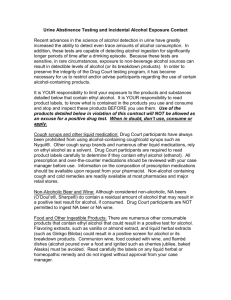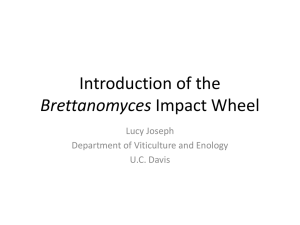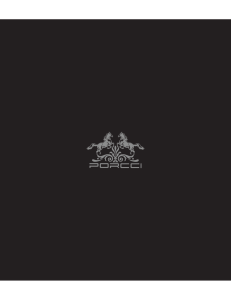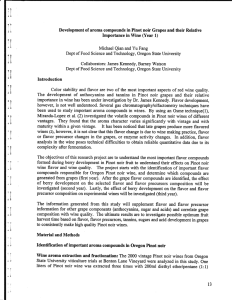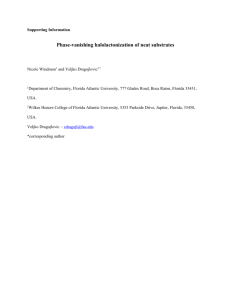Access the file
advertisement
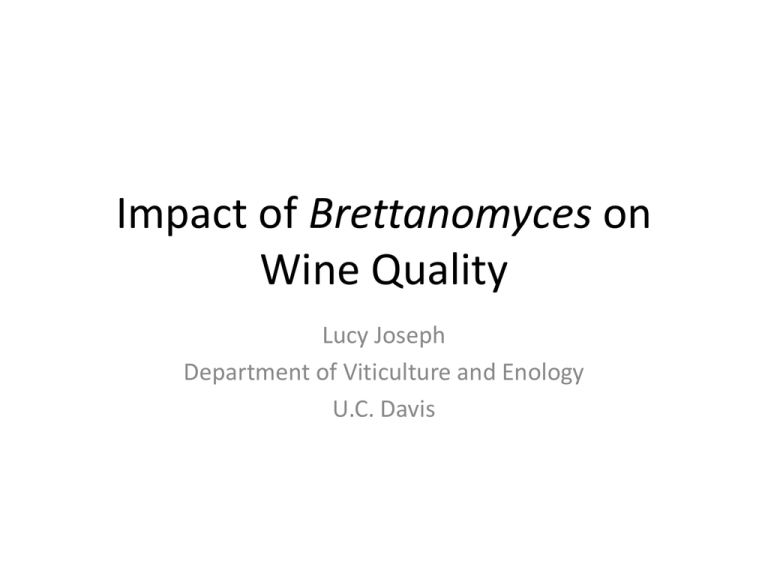
Impact of Brettanomyces on Wine Quality Lucy Joseph Department of Viticulture and Enology U.C. Davis Introduction • Brettanomyces is considered to be the primary spoilage yeast in finished wine • However, many consumers and critics like the complexity that is derived from Brett growth in wine Compounds Produced by Brett in Wine • Signature spoilage compounds - ethyl phenols, vinyl phenols • Other spoilage compounds – acetic acid, ethyl acetate, fatty acid, carboxylic acid • Compounds that are positive – Esters, higher alcohols, terpenes Strain Collection Alcohol Aldehyde Ester Ethyl Phenol Fatty Acid Terpene Vinyl Phenol Isoamyl Nonanal Ethyl butanoate 4-ethylphenol Butanoic Ocimene 4-vinylphenol Amyl (active) Pentyl formate 4-ethylguaiacol Heptanoic Bisabolene 4-vinylguaiacol 2-ethyl hexanol Ethyl isovalerate Phenethyl Ethyl valerate 2-methoxy phenyl Ethyl 2methylbuty rate Undecanoic Octylbutyrate Amyloctanoate Phenethyl formate Fruit/floral chemical Artificial fruit/floral Artificial fruit/floral Chemical, smoke/spice Sweaty/rott en cheese Floral resin Spicy wood spice smoke medicinal Initial Screen • Defined medium was used • Supplemented with amino acids • All strains will make 4EP and 4EG with coumaric and ferulic acids Percentage of evaluations Positive and Negative Perception 100% 90% 80% %+/- 70% %- 60% %+ 50% 40% 30% 20% 10% 0% 1 3 5 7 9 11 13 15 17 19 21 23 25 27 29 31 33 35 37 39 41 43 45 47 49 51 53 55 57 59 61 63 65 67 69 71 73 75 77 79 81 83 Strains Selection for Test in Wine • Descriptors, intensity, and likability used to score strains • Out of the initial 83 that were successfully screened in the initial screen, 17 were chosen as “positive” and 5 as “negative” Summary of Aroma for Strains Tested in Wine Table 5 Aroma summary of strains selected for growth in wine Likeability Number of aroma descriptors by category* Strain Intensity + +/- Sa An R So Ac M Fe D Sp W Fl Fr V 605 2.89 16% 58% 26% 0 1 2 4 11 0 4 0 2 1 6 2 0 2404 3.10 10% 40% 50% 0 2 5 5 3 0 8 0 1 1 8 2 1 2051 4.75 8% 42% 50% 3 2 2 4 4 0 5 0 0 1 12 0 0 2408 4.19 19% 44% 38% 0 3 3 3 5 0 4 1 3 4 1 5 0 2504 3.00 19% 31% 50% 1 3 0 1 4 0 5 2 3 5 4 3 1 2402 4.50 25% 13% 63% 2 1 2 2 3 0 4 2 0 2 3 0 0 2406 2.75 13% 50% 38% 1 1 1 2 2 0 2 1 0 3 2 0 0 2509 4.44 8% 50% 42% 0 0 7 0 5 0 2 2 3 2 6 0 0 2066 2.68 40% 30% 29% 1 0 0 3 3 3 4 2 3 0 4 1 1 2091 4.93 0% 42% 58% 1 3 2 3 7 0 4 1 0 5 6 3 2 2752 5.50 0% 38% 63% 0 0 5 4 4 0 1 0 0 3 2 0 0 2508 4.69 0% 58% 42% 0 1 6 2 2 2 3 1 4 3 3 0 3 2385 3.83 0% 45% 55% 0 4 5 4 6 0 8 0 1 3 7 0 0 2505 3.44 0% 50% 50% 0 2 3 2 3 0 7 3 1 5 4 5 0 2092** 6.08 0% 88% 13% 2 1 8 3 6 0 3 0 0 3 4 1 1 2077** 5.00 0% 67% 33% 2 5 6 3 9 0 4 0 1 0 3 0 0 *Sa=savory, An=animal, R=Rotten/Putrid, So=solvent, Ac=acetic, M=musty, Fe=fermentation, D=dairy, Sp=spicy, W=woody, Fl=floral, Fr=fruity, V=veggie **denotes “negative controls” ffffffffff ffffffffff 32 ffffffffff ffffffffff SPME-GCMS • These strains were also screened chemically • Used defined medium supplemented with – Aromatic amino acids – Cinnamic acids and aromatic amino acids • Goal was to identify strains that produced low negative characters Cluster Analysis of Strains Important Compounds That Determine Differences With Amino Acids Relative Concentration of Compounds in “Most Liked” Strains – Amino Acid Supplemented • Phenethyl acetate – Sweet, honey, floral rosy • Ethyl decanoate – sweet, waxy, fruity, apple • Ethyl hexanoate – sweet, fruity, pineapple, waxy green banana • Ethyl octanoate – fruity, wine, waxy, sweet • 2-phenylethanol – floral, rose, rose water • Octanoic acid – fatty, rancid oil, cheesy • Ethyl acetate – nail polish remover, solvent • 3-methylbutanoic acid – sour, stinky feet, sweaty, cheese • Decanoic acid – rancid, sour, fatty, citrus • 2-phenylacetaldehyde – honey, sweet, rose, green, grassy Important Compounds That Determine Differences With Cinnamic and Amino Acids Relative Concentration of Compounds in “Most Liked” Strains – Amino Acid and Phenolic Acid Supplemented • • • • • • • • • • Ethyl octanoate – fruity, wine, waxy, sweet 2-phenylethanol – floral, rose, rose water Ethyl decanoate – sweet, waxy, fruity, apple 4-ethylphenol – medicinal, Band-Aid, barnyard 4-ethylguaiacol – spicy, smoky, phenolic, clove Octanoic acid – fatty, rancid oil, cheesy Decanoic acid – rancid, sour, fatty, citrus Phenethyl acetate – Sweet, honey, floral rosy Ethyl acetate – nail polish remover, solvent Decanol – waxy, floral, orange, sweet Wine Descriptions (under $25) • • • • • • • • • • • rose petal and earl grey tea, baking spices pepper, baking spices, flowers violets and spices bittersweet iris-like, brioche as well as butter black licorice and roasted herbs mocha and anise spice, licorice and wild bush, mineral peppery spice, dust fruit with nutty, savory complexity popcorn, brioche, grilled nuts smoke-accented aromas, cola and spices Wine Descriptions ($25 to $50) • forest floor, black pepper, moss covered tree bark and game • potpourri and orange zest, with a subtle smoky overtone; spicy floral, loamy earth, cedar and savory herb • Sappy, spice-accented, medicinal cherry note, with clinging spicecake and cracked pepper • musky aromas, smoked meat, bacon fat and licorice and chocolate flavors • smoky, savory; smoke and bacon with chocolaty finish; violets and baking spices • bread crust, coffee and dark chocolate and a touch of spices • crushed rock, camphor, and a hint of pen ink • smoked meat, cracked pepper, tobacco and masses of crushed stone / mineral • creosote, minerals, and toasty oak • incense and rose oil; sandalwood and tea leaf Wine Descriptions ($50 to $75) • black truffles, roasted meats, charcuterie, incense, roasted herbs and licorice; spiceaccented aromas and potpourri, hint of spicecake; charcoal notes, long, tarry finish • graphite, savory herbs, white flowers, orange peel, spices, nutmeg, clove; mineral and cedar; violet, grilled meat and tar, cassis and licorice • bay leaf, sage, anise, toast and chocolate, mineral and earth; roasted coffee, herb; earthy black currant and fig, and charcoal-infused fruit • exotic, smoky oak; sage and underbrush, even a touch of gun oil Using Descriptors • Wines were purchased from an online site by searching using descriptors from the aroma wheel • These wines were tested for the presences of microbes by plating, microscopy, and qPCR • Wines were also analyzed for 4EP and 4EG What We Found • 35 wines were selected • 17 had viable lactic acid bacteria by plating (49%) • 9 had viable Brett by plating • An additional 5 had Brett by qPCR • Another 4 had Brett by 4EP and 4EG levels • A total of 18 showed evidence of Brett (51%) • All of the wines were positive for microbial contamination
